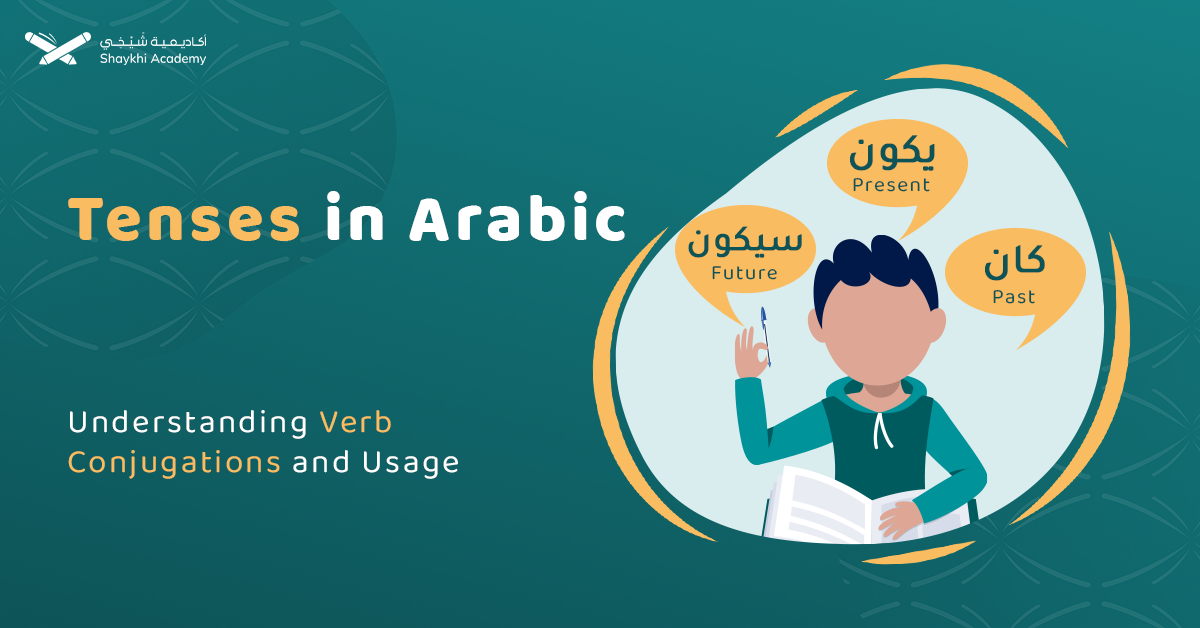Arabic verbs (أفعال / Af’aāl are underpinned on a set of two to five (often three) letters called a word root, these letters are always consonants.
The verb root can be triliteral, quadriliteral or quintuple according to the number of its consonants. The root announces the basic meaning of the verb,
- e.g Beat: ضرب / D-r-b
- Go: ذهب / Th-h-b
- Write: كتب / K-t-b
Adding prefixes or suffixes to the verb root is specified by the function of the sentence subject that follows the verb such as person, gender, and number. It is also specified by other elements such as the sentence tense, mood, and voice.
In this full-scale deliberation, we will shed light on facets of Arabic grammar tenses, their types, their functions, conjugation forms, with examples to broaden your understanding of this distinguished language. Go no further.
Introduction to the Arabic Root System to understand the tenses
The root in Arabic refers to the origin of a word, known in singular form as “Jazr” and in plural form as “Jozor”. A root typically consists of three or four consonants and represents the core meaning or concept of a word.
By using a root, you can create other Arabic words by adding short or long vowels, or by adding consonants while keeping the core meaning and structure of the root through a connected link.
Let’s explore an example:
Example:
- The root word (كتب), pronounced kataba, means “someone who wrote something.” it consists of three letters kaf(ك) taa(ت) and baa(ب)
- By adding the letter alef (ا), it becomes (كاتب), pronounced kateb, meaning “a writer.”
- Adding the letter meem (م) forms (مكتب), pronounced maktab, meaning “a desk.”
- If you add both waw (و) and meem (م), it becomes (مكتوب) pronounced maktoub, meaning “something that has already been written.”
How Many Verb Tenses are There in Arabic?
In Arabic, there are three primary verb tenses: the Past (الماضي), Present (المضارع), and Command (الأمر). Additionally, Arabic has a Future form, which is created by modifying the present tense with certain prefixes, although it is often viewed as an extension of the present rather than a separate tense.
Important notes:
1. The future formula is not a tense as a linguistic law. But we included it as a part of all recognized tenses in all other languages.
2. If the root of the verb is tripartite, we add (ا) to the past form to turn it into the command form. But this Alf (ا) should be without (ء) on its top or its bottom.
Example:
فتح (اِفْتَح) لعب (اِلْعَب) كتب (اُكتُب)
Verb Tenses in Arabic
Arabic tenses are predominantly divided into three tenses; Past Tense (الماضي), Present Tense (المضارع), and Command Tense (الأمر). These tenses are substantive in expressing actions at different times. Arabic tenses are the core of the Arabic Language, and the indispensable elements of Arabic grammar, they point out actions and proper times of actions.
To master these indispensable elements of Arabic tenses, you need to join a linguistic grammar course, Shaykhi Academy’s Online Fusha Arabic Course provides exquisite education and exceptional practice on Fusha Arabic tenses. This skill is essential for effective communication across the Arab world.
On the following lines, we will briefly shed light on the different kinds of the verb tenses in the Arabic language.
Arabic Past Tense /الماضي
In Arabic past tense called (Al madi) indicates to an action already occured, for example the verb (قرأ)pronounced karaa which means that” he red something” a book for example.
The past tense refers to actions that have already started and ended in the past. In Arabic
grammar, the past tense has a straight conjugation formula. It is the same as the form of the word root. It remains unchanged all along with different modifications.
Examples of Arabic past tense verbs:
- He played – لعب / La”aba
- They played – لعبوا / La’i boo
- We played – La’ anna / لعبنا
Sentence Examples:
- كتب على الدرس. Ali wrote the lesson.
- أكل الأب برتقالة. The father ate an orange.
- نجح الولد في الامتحان. The boy passed the exam.
Arabic Present Tense / المضارع
In Arabic present tense called (Al modaree) indicates to an action that still occurring, for example the verb(يقرأ) pronounced yakraa which means “he is reading”
The Arabic present tense describes actions that occur in the present or those ongoing actions. The present tense conjugation patterns are more multifaceted than the past tense. It has various forms indicating various linguistic aspects.
Examples of Arabic present tense verbs:
- He plays يلعب / yal”ab
- They play – يلعبون / yal’aboon
- We play – نلعب / Na’lab
Sentence Examples:
- يكتب على الدرس Ali writes the lesson.
- يأكل الأب البرتقالة. The father eats an orange.
- يشرب الولد اللبن. The boy drinks milk.
Arabic Command Tense /الأمر
In Arabic command tense called (Al amr) indicates to an action should be done, for example, the verb (اقرأ) pronounced Iqraa means “you must read”
The command tense of the Arabic language is used to give imperative orders. Therefore, it is always used to give obligations to the second person.
It is often formed by adding the Arabic letter (ا) before the root of the verb.
Examples of Arabic command tense verbs:
- Play – اِلعَبْ / ALa”ab
- Play اِلعَبوا / ALa’i boo
Arabic Future Tense / المستقبل
The Arabic future pattern is considered the fourth Arabic tense according to a linguistic norm not a linguistic law. It refers to actions and events that are expected to happen in the future. The future tense verb is formed by adding the prefix ( س / sa); or by adding the particle ( سوف /sawfa) to the present verb form.
Examples of Arabic future tense verbs:
- He will sleep.
- سينام / sayanam
- They will play.
- سيلعبون / sayal’aboon
- We will play
- سنلعب / Sana’lab
Examples:
- سيكتب على الدرس Ali will write the lesson.
- سيأكل الأب برتقالة The father will eat an orange.
- سيشرب الولد اللبن The boy will drink milk.
For a deep understanding of Arabic tenses, it is all-important to bear in mind other linguistic elements such as the mood and aspect of the sentence. The more a learner masters these linguistic elements, the more they enhance their Arabic language proficiency.
Arabic Regular Verbs ( الفِعْلُ الصَّحِيْح)
The stem of these verbs does not contain an Arabic vowel letter (و ، ا ، ي), so they are named regular verbs. The regular verb in a past formula always ends with fat’ha mark on the last letter.
1. Regular Verbs Usages in Arabic
We use a regular verb to form an Arabic sentence in the past tense with the third person masculine/ singular. Look at the following examples:
- دَخلَ الحجرة. He entered the room.
- قَرأَ الرسالة. He read the message.
- كَسرَ الكوب. He broke the glass.
- فَتحَ الباب. He opened the door.
2. Arabic Regular Verbs Conjugation
When the regular verbs Conjugated into the forms of all other verbs, they do not infringe the stipulated rules.
Conjugation in the Arabic language means changing the verb form to be consistent with the sentence subject, tense, and mood. It may seem a complex process, but once you master the basics,it will become easier.
A. Examples of Regular Verbs Conjugation
When the sentence subject is the third person/ masculine, the verb conjugation will be as follows:
1. Omar entered the room. (Past) – دخل عمر الحجرة.
2. Omar is entering the room. (Present) – يدخل عمر الحجرة
3. Omar, enter the room. (Command) أدخل يا عمر الحجرة.
When the subject is third person/ female, the verb conjugation will be as follows:
1. Heba entered the room. (Past) دخلت هبه الحجرة
2. Heba is entering the room. (present) تدخل هبة الحجرة
3. Heba, enter the room. (Command) ادخلي يا هبه الحجرة
3. Regular Verbs Negation
When the sentence subject is the third person/ masculine, negative verb will be as follows:
1. Omar didn’t enter the room. (Past) لم يدخل عمر الحجرة
2. Omar is not entering the room. (Present) لا يدخل عمر الحجرة
3. Omar, don’t enter the room. (Command) لا تدخل يا عمر الحجرة
When the subject is third person/ female, the negative verb will be as follows:
1. Heba didn’t enter the room. (Past) لم تدخل هبة الحجرة
2. Heba is not entering the room. (present) لا تدخل هبة الحجرة
3. Heba, don’t enter the room. (Command) لا تدخلي يا هبه الحجرة
Arabic Healthy Salim Verbs (الفعل الصحيح السالم)
The Healthy Salim Verb is a division of the regular verbs. It is the verb that none of its letters is hamza (ء), or a doubled letter,(لل – نن- مم…etc) or a vowel letter (ا، ي، و).
Look at the following schedule, it contains examples for this point.
| Present | Past | Command |
| يشرب | شرب | اِشْرَبْ |
| يجلس | جلس | اِجْلِسْ |
| يذاكر | ذاكر | ذَاكرْ |
| يدرس | درس | أُدْرُس |
1. Healthy Salim Verbs Usage
Look at the following examples, they contain some of the healthy salim verbs usages.
1. Omar drank milk. شرب عمر اللبن
2. Omar sit on the ground. جلس عمر على الارض
3. Omar studied his lessons. ذاكر عمر دروسه
2. Healthy Salim Verbs Conjugation
We have collected some various examples for each verb conjugation in different tenses; future, command, present, and past as follows:
1.Omar will visit his uncle. (سَيَزُورُ عمر عَمَّهُ)
2. Visit your uncle, Omar! (زُرْ يَا عُمَر عَمَّكَ)
3. Omar visits his uncle. (يَزُورُ عُمَرعَمَّهُ)
4. Omar visited his uncle. (زَارَ عُمَرعَمَّهُ)
1. The kids will go to bed early. (سَيَنَامُ أَلأَطْفَالُ مُبَكِّرَاً)
2. O, kids, Go to bed early. (ًأيُها الأطفال، نَاموا مُبَكِّرَا)
3. Kids go to bed early. (يَنَامُ الأَطْفالُ مُبَكِّرَاً)
4. The kids went to bed early. (نَامَ الاطْفالُ مُبَكِّرَاً)
1. We will read the book. (سَنَقرَأُ الكِتَابَ)
2. Read the book, guy. (يا أولاد، اِقْرَؤا الكِتَابَ)
3. We read the book. ( نَقْرَأُ الكِتَابَ)
4. We read the book. ( قَرَأنَا الكِتَابَ)
3. Healthy Salim Verbs Negation
Look at the following examples, they contain some negative forms for the healthy salim verbs.
1. Omar will not visit his uncle.
(لن يَزُورُ عمر عَمَّهُ)
2. Don’t visit your uncle, Omar!
(لا تَزرْ يَا عُمَر عَمَّكَ)
3. Omar doesn’t visit his uncle.
(لا يَزُورُ عُمَرعَمَّهُ)
4. Omar did not visit his uncle.
(لم يَزرَ عُمَرعَمَّهُ)
1. The kids will not go to bed early.
(لن يَنَامُ أَلأَطْفَالُ مُبَكِّرَاً)
2. Don’t go to bed early.
(لا تنم مُبَكِّرَاً)
3. The kids don’t go to bed early.
(لا يَنَامُ الأَطْفالُ مُبَكِّرَاً)
4. The kids didn’t go to bed early.
(لم يَنمْ الاطْفالُ مُبَكِّرَاً)
1. We will not read the book.
(لن نَقرَأ الكِتَابَ)
2. Don’t read the book, guys.
(لا تقْرَؤا الكِتَابَ)
3. We don’t read books.
(نَحْنُ لا نَقْرَأ الكُتَبَ)
4. We didn’t read books.
(نَحْنُ لم نقَرَأ الكُتَبَ)
Arabic Tenses Chart
In the following chart, Arabic tenses with a relevant translation are displayed.
| Present المصارغ | Past الماضي | Command الأمر | Future المستقبل |
| يلعب play | لعب played | ِالعب play | سيلعب will play |
| يمشي walk | مشي walked | اِمشي walk | سيمشي will walk |
| يأكل eat | أكل ate | كل eat | سيأكل will eat |
| يضرب beat | ضرب beat | اِضرب beat | سيضرب will beat |
| ينام sleep | نام slept | نم sleet | سينام will sleep |
| يحب like | أحب liked | أَحب like | سيحب will like |
| يفكر think | فكر thought | فكر think | سيفكر will think |
| يساعد help | ساعد helped | سَاعِد help | سيساعد will help |
| يعمل work | عمل worked | اعمل work | سيعمل will work |
| يغني sing | يغني sang | غني sing | سيغني will sing |
Which Tense Do You Want to Learn?
Explore the Arabic language affluence and abundance of its various tenses with Shaykhi Academy’s Learn Arabic Online Course. It caters to all levels from beginners to advanced learners. It covers essential language components and critical skills like reading, writing, grammar, and listening.
Shaykhi Academy’s all-inclusive curriculum provides an immersive learning experience by expert instructors. It was tailored in a way that deepens the learner’s understanding to enable them to master this vital language.
Shaykhi Academy’s Learn Arabic Online Course will provide you with professional education under the auspices of experienced tutors like Dr. Mahmoud AlAssal and Sh. Luqman ElKasabany, this will result in a positive impact on your language skills. Shaykhi academy has many authentic tutors graduated from Al-azhr Ash-sharif University with long educational experience in the Arabic grammar teaching field. It is a very crucial matter that you should be taught under the aegis of such quality.
Why Shaykhi Academy?
- Expert Native Tutors: Learn from highly qualified native Arabic speakers.
- Flexible Scheduling: Tailor your classes to fit your busy life.
- Affordable Learning: Access top-quality education at a price that suits you.
- Global Access: Study from anywhere in the world.
Explore Our Arabic Courses:
- Noorani Qaida: Build a strong foundation in Quranic Arabic.
- Comprehensive Arabic Courses: Master the Arabic language, from beginner to advanced levels.
- Fusha Arabic Classes: Delve into Modern Standard Arabic, the key to understanding literature, media, and formal communication across the Arab world.
- Quranic Arabic Course: Enhance your connection with the Quran by learning the language in which it was revealed.
Start Your Arabic Journey Today! Whether you’re just starting or looking to deepen your knowledge, Shaykhi Academy is here to support your journey. Book your free trial now and begin your path to Arabic mastery!

Conclusion
Arabic is a deeply rooted language. It goes back to thousands of years ago. The basis for mastering any language is based on a successful acquisition through grammatical theories of Arabic tenses that requires a profound understanding. Mastering those tenses enables the learners to use the Arabic Language professionally.

















































